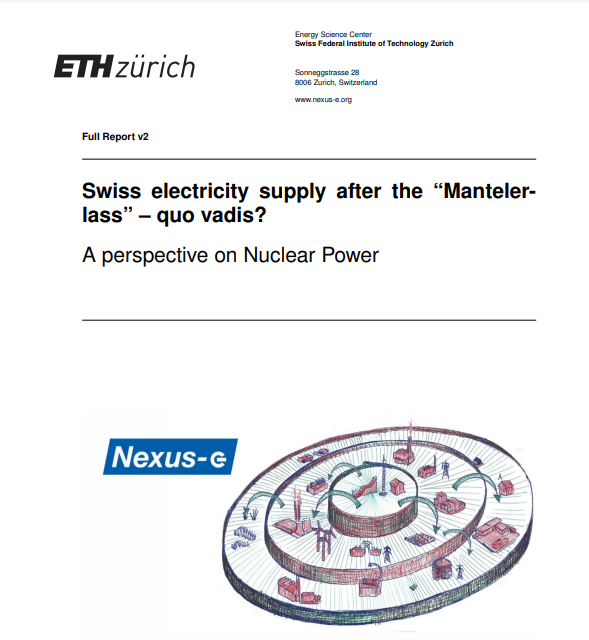In this report we assess four scenarios:
- The reference scenario represents the status quo of Swiss nuclear power plant (NPP) lifetime, meaning 60 years for Beznau I and II, and 50 years for Goesgen and Leibstadt.
- In the NPP60 scenario, we assume that the NPPs Goesgen and Leibstadt get the approval to operate also for 60 years.
- In the NPP6580 scenario, Beznau I and II operate for 65 and Leibstadt and Goesgen for 80 years.
- In the NPP60+ scenario, we assume that on top of 60 years operating time for all existing NPPs also a new NPP is being constructed in 2040.

Download the full report ( 1,394 KB)
Download the extended summary (945 KB)
Check out all results in our interactive webviewer
Key results
Result 1: With current policies and regulations, the targets for the installation of Renewables set in the “Mantelerlass” might be challenging to achieve. Extending the duration of subsidies, for example, for alpine PV beyond 2025, could be helpful. A combination of both a lack of Renewable installations and a phase-out of nuclear power before 2050 can lead to higher winter imports compared to today.
Figure 1: Installed generation capacities (1a) and winter net imports in the reference scenario (1b).
Result 2: A longer operation of NPPs can provide electricity in winter and therefore reduce imports during these months. Such additional domestic electricity generation might also reduce the total costs of electricity supply and mitigate the increase in electricity prices.
Constructing a new NPP reduces winter net imports and electricity prices further, compared to the NPP60 scenario. Total electricity supply costs are, however, strongly dependent on the assumed investment costs. With investment costs of NPPs in Europe that are currently under construction or have been recently completed, the NPP60+ scenario results in substantially higher costs compared to the scenario without a new nuclear power plant.
Figure 2: Comparison of the reference, NPP60, and NPP6580 scenarios in terms of net imports during
winter (2a), total electricity supply costs (2b), and electricity market prices (2c).
Results 3: Open-field renewables with high shares of winter electricity generation such as alpine PV and wind power are another option to reduce electricity imports during winter. Alpine PV produces up to 55 percent of its electricity in the winter half-year, and wind power even more with around 60 percent. Generally, we see that the earlier nuclear power is phased out, the faster renewable capacity has to be expanded to keep winter net imports at low values.
Figure 7: Monthly electricity generation in 2050 for the reference scenario (7a) and scenarios with longFigure 7: Monthly electricity generation in 2050 for the reference scenario (7a) and scenarios with long
NPP operation (i.e., NPP6580) (7b) and strong renewable expansion (7c)Figure 3: Monthly electricity generation in 2050 for the reference scenario (3a) and scenarios with long
NPP operation (i.e., NPP6580) (3b) and strong renewable expansion (3c)
NPP operation (i.e., NPP6580) (7b) and strong renewable expansion (7c)
Results 4: The operation of NPPs likely changes in a future Swiss electricity system that is strongly based on hydropower and intermittent renewables such as wind and solar power. Today, Swiss NPPs typically run most of the time at rated power and are shut down during refueling and unplanned outages. However, in the future, they might operate more in winter and during times of low renewable generation. Such operation might be more suitable for new NPPs with fast ramp rates.
Figure 4: Hourly electricity generation by nuclear power plants (4a) historically and (4b) in 2050 for the
NPP60+ scenario.
Generally, we see a similar value of NPPs across all sensitivities. For all basic scenarios, we test three sensitivities. We evaluate the impact of different developments in neighboring countries, of electricity trade restrictions (considering the potential impact of the EU clean energy package), and of higher electricity demand due to domestic hydrogen production.
Please note that the scenarios refer purely to the techno-economic representation of nuclear power plants. Other aspects such as the risk of nuclear catastrophes, the final disposal of nuclear waste, the dependence on uranium imports, or the uncertainties in construction costs and duration of planning and building a new power plant are not considered. Also, the results of this study are intended to provide quantitative insight into the scenario differences but do not serve as forecasts. The modeling of the Swiss electricity system is subject to many assumptions and simplifications. The total costs of the scenarios do not include the costs of the required expansion of the transmission and distribution grid.

